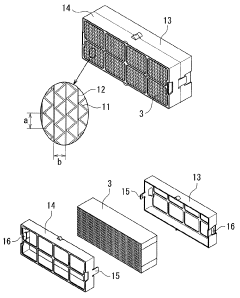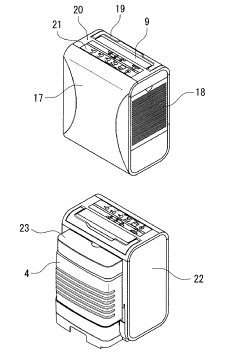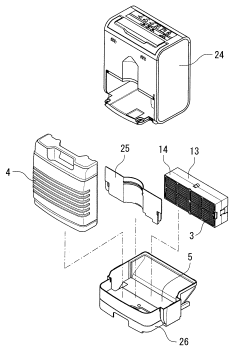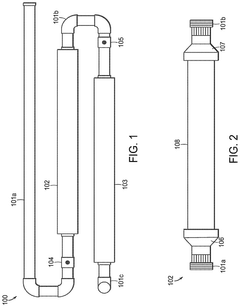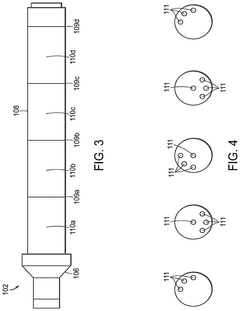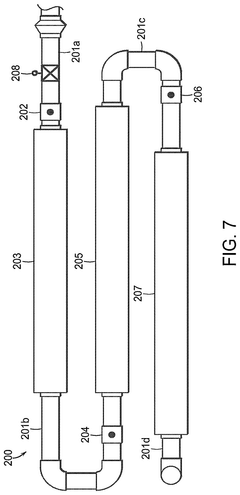Hypochlorous Acid in Improving Indoor Air Quality Standards
AUG 4, 20258 MIN READ
Generate Your Research Report Instantly with AI Agent
Patsnap Eureka helps you evaluate technical feasibility & market potential.
HOCL Air Quality Goals
The primary goal of utilizing hypochlorous acid (HOCl) in improving indoor air quality standards is to create a safer, healthier, and more comfortable environment for occupants. This objective aligns with the growing awareness of the importance of indoor air quality in various settings, including homes, offices, schools, and healthcare facilities.
One of the key aims is to reduce the concentration of airborne pathogens, including bacteria, viruses, and fungi, which can cause respiratory infections and other health issues. HOCl has demonstrated significant efficacy in neutralizing a wide range of microorganisms, making it a promising solution for enhancing air sanitation. By effectively eliminating these harmful particles, the technology seeks to minimize the risk of disease transmission in enclosed spaces.
Another important goal is to address the issue of volatile organic compounds (VOCs) and other chemical pollutants that can accumulate in indoor environments. These substances, often emitted from building materials, furnishings, and cleaning products, can lead to various health problems, including headaches, eye irritation, and respiratory issues. The implementation of HOCl-based air purification systems aims to break down these compounds, thereby improving overall air quality and reducing potential health risks.
Odor control is another significant objective in the application of HOCl for indoor air quality improvement. Many indoor spaces suffer from unpleasant odors caused by various factors such as cooking, pets, or mold growth. HOCl's powerful oxidizing properties can effectively neutralize odor-causing molecules, leading to fresher and more pleasant indoor environments.
Furthermore, the technology aims to provide a sustainable and eco-friendly alternative to traditional air purification methods. Unlike some chemical-based air fresheners or disinfectants that may introduce additional pollutants into the air, HOCl breaks down into harmless byproducts, making it a more environmentally responsible choice for long-term use in indoor spaces.
Lastly, the implementation of HOCl in air quality improvement systems seeks to meet or exceed existing indoor air quality standards and regulations. As these standards become increasingly stringent, particularly in sensitive environments like healthcare facilities and schools, HOCl technology aims to provide a reliable and effective solution that can adapt to evolving requirements and ensure compliance with regulatory guidelines.
One of the key aims is to reduce the concentration of airborne pathogens, including bacteria, viruses, and fungi, which can cause respiratory infections and other health issues. HOCl has demonstrated significant efficacy in neutralizing a wide range of microorganisms, making it a promising solution for enhancing air sanitation. By effectively eliminating these harmful particles, the technology seeks to minimize the risk of disease transmission in enclosed spaces.
Another important goal is to address the issue of volatile organic compounds (VOCs) and other chemical pollutants that can accumulate in indoor environments. These substances, often emitted from building materials, furnishings, and cleaning products, can lead to various health problems, including headaches, eye irritation, and respiratory issues. The implementation of HOCl-based air purification systems aims to break down these compounds, thereby improving overall air quality and reducing potential health risks.
Odor control is another significant objective in the application of HOCl for indoor air quality improvement. Many indoor spaces suffer from unpleasant odors caused by various factors such as cooking, pets, or mold growth. HOCl's powerful oxidizing properties can effectively neutralize odor-causing molecules, leading to fresher and more pleasant indoor environments.
Furthermore, the technology aims to provide a sustainable and eco-friendly alternative to traditional air purification methods. Unlike some chemical-based air fresheners or disinfectants that may introduce additional pollutants into the air, HOCl breaks down into harmless byproducts, making it a more environmentally responsible choice for long-term use in indoor spaces.
Lastly, the implementation of HOCl in air quality improvement systems seeks to meet or exceed existing indoor air quality standards and regulations. As these standards become increasingly stringent, particularly in sensitive environments like healthcare facilities and schools, HOCl technology aims to provide a reliable and effective solution that can adapt to evolving requirements and ensure compliance with regulatory guidelines.
Indoor Air Market Analysis
The indoor air quality market has experienced significant growth in recent years, driven by increasing awareness of the health impacts of poor air quality and the rising prevalence of respiratory diseases. The global indoor air quality market was valued at $12.26 billion in 2021 and is projected to reach $18.29 billion by 2028, growing at a CAGR of 6.9% during the forecast period. This growth is attributed to factors such as urbanization, industrialization, and the COVID-19 pandemic, which have heightened concerns about indoor air pollution.
The residential sector dominates the indoor air quality market, accounting for over 60% of the total market share. This is due to the increasing adoption of air purifiers, ventilation systems, and air quality monitors in homes. The commercial sector, including offices, schools, and healthcare facilities, is also a significant contributor to market growth, driven by stringent regulations and the need to maintain healthy indoor environments for employees and customers.
Geographically, North America holds the largest market share, followed by Europe and Asia-Pacific. The United States, in particular, leads the market due to stringent air quality regulations and high consumer awareness. However, the Asia-Pacific region is expected to witness the fastest growth, driven by rapid urbanization, increasing disposable income, and growing health consciousness in countries like China and India.
The market for hypochlorous acid (HOCl) in indoor air quality applications is a niche but rapidly growing segment. HOCl is gaining traction as an effective and eco-friendly disinfectant for air and surface treatment. The global HOCl market size was valued at $198.9 million in 2020 and is expected to grow at a CAGR of 7.8% from 2021 to 2028. While this market includes various applications, the use of HOCl in air purification systems is becoming increasingly popular due to its ability to eliminate a wide range of pathogens without harmful residues.
Key market drivers for HOCl in indoor air quality applications include its effectiveness against viruses and bacteria, its non-toxic nature, and its potential to improve overall air quality standards. The healthcare sector is currently the largest end-user of HOCl-based air purification systems, followed by the hospitality industry and educational institutions. As research continues to demonstrate the efficacy of HOCl in improving indoor air quality, it is expected to gain wider adoption across various sectors, potentially reshaping the indoor air quality market landscape in the coming years.
The residential sector dominates the indoor air quality market, accounting for over 60% of the total market share. This is due to the increasing adoption of air purifiers, ventilation systems, and air quality monitors in homes. The commercial sector, including offices, schools, and healthcare facilities, is also a significant contributor to market growth, driven by stringent regulations and the need to maintain healthy indoor environments for employees and customers.
Geographically, North America holds the largest market share, followed by Europe and Asia-Pacific. The United States, in particular, leads the market due to stringent air quality regulations and high consumer awareness. However, the Asia-Pacific region is expected to witness the fastest growth, driven by rapid urbanization, increasing disposable income, and growing health consciousness in countries like China and India.
The market for hypochlorous acid (HOCl) in indoor air quality applications is a niche but rapidly growing segment. HOCl is gaining traction as an effective and eco-friendly disinfectant for air and surface treatment. The global HOCl market size was valued at $198.9 million in 2020 and is expected to grow at a CAGR of 7.8% from 2021 to 2028. While this market includes various applications, the use of HOCl in air purification systems is becoming increasingly popular due to its ability to eliminate a wide range of pathogens without harmful residues.
Key market drivers for HOCl in indoor air quality applications include its effectiveness against viruses and bacteria, its non-toxic nature, and its potential to improve overall air quality standards. The healthcare sector is currently the largest end-user of HOCl-based air purification systems, followed by the hospitality industry and educational institutions. As research continues to demonstrate the efficacy of HOCl in improving indoor air quality, it is expected to gain wider adoption across various sectors, potentially reshaping the indoor air quality market landscape in the coming years.
HOCL Tech Challenges
The development of hypochlorous acid (HOCl) technology for improving indoor air quality faces several significant challenges. One of the primary obstacles is the stability of HOCl solutions. These solutions tend to degrade rapidly, losing their effectiveness over time. This instability poses difficulties in storage, transportation, and long-term use, limiting the practical application of HOCl in air purification systems.
Another major challenge lies in the production of HOCl at a consistent concentration. The efficacy of HOCl in air purification depends heavily on maintaining an optimal concentration. However, current production methods often result in variations in concentration, which can affect the overall performance and reliability of HOCl-based air quality improvement systems.
The potential for by-product formation during HOCl generation and use is also a significant concern. Some production methods may lead to the creation of unwanted compounds, such as chlorine gas or trihalomethanes, which can themselves be harmful to human health and indoor air quality. Addressing this issue requires advanced production techniques and careful monitoring of the HOCl generation process.
Scalability presents another hurdle in the widespread adoption of HOCl technology for indoor air quality improvement. While HOCl has shown promise in small-scale applications, scaling up the production and distribution for large commercial or industrial spaces remains challenging. This includes issues related to on-site generation, distribution systems, and maintaining effectiveness across large areas.
The interaction of HOCl with various materials commonly found in indoor environments is yet another area of concern. HOCl's oxidizing properties, while beneficial for air purification, may potentially cause degradation or corrosion of certain surfaces or equipment. This necessitates comprehensive compatibility studies and the development of appropriate application methods and protective measures.
Regulatory and safety considerations also pose challenges to the widespread implementation of HOCl technology. As a relatively new approach to indoor air quality improvement, HOCl faces scrutiny from regulatory bodies. Establishing safety standards, obtaining necessary approvals, and ensuring compliance with existing air quality regulations are crucial steps that require significant time and resources.
Lastly, there is a need for more extensive research on the long-term effects of HOCl exposure in indoor environments. While short-term studies have shown promising results, the impact of prolonged exposure to low levels of HOCl on human health and indoor ecosystems is not yet fully understood. This gap in knowledge presents a challenge in gaining widespread acceptance and implementation of HOCl technology for indoor air quality improvement.
Another major challenge lies in the production of HOCl at a consistent concentration. The efficacy of HOCl in air purification depends heavily on maintaining an optimal concentration. However, current production methods often result in variations in concentration, which can affect the overall performance and reliability of HOCl-based air quality improvement systems.
The potential for by-product formation during HOCl generation and use is also a significant concern. Some production methods may lead to the creation of unwanted compounds, such as chlorine gas or trihalomethanes, which can themselves be harmful to human health and indoor air quality. Addressing this issue requires advanced production techniques and careful monitoring of the HOCl generation process.
Scalability presents another hurdle in the widespread adoption of HOCl technology for indoor air quality improvement. While HOCl has shown promise in small-scale applications, scaling up the production and distribution for large commercial or industrial spaces remains challenging. This includes issues related to on-site generation, distribution systems, and maintaining effectiveness across large areas.
The interaction of HOCl with various materials commonly found in indoor environments is yet another area of concern. HOCl's oxidizing properties, while beneficial for air purification, may potentially cause degradation or corrosion of certain surfaces or equipment. This necessitates comprehensive compatibility studies and the development of appropriate application methods and protective measures.
Regulatory and safety considerations also pose challenges to the widespread implementation of HOCl technology. As a relatively new approach to indoor air quality improvement, HOCl faces scrutiny from regulatory bodies. Establishing safety standards, obtaining necessary approvals, and ensuring compliance with existing air quality regulations are crucial steps that require significant time and resources.
Lastly, there is a need for more extensive research on the long-term effects of HOCl exposure in indoor environments. While short-term studies have shown promising results, the impact of prolonged exposure to low levels of HOCl on human health and indoor ecosystems is not yet fully understood. This gap in knowledge presents a challenge in gaining widespread acceptance and implementation of HOCl technology for indoor air quality improvement.
Current HOCL Solutions
01 Air purification using hypochlorous acid
Hypochlorous acid is utilized in air purification systems to improve indoor air quality. It acts as a powerful disinfectant, effectively eliminating airborne pathogens, bacteria, and viruses. These systems can be integrated into HVAC units or used as standalone devices for various indoor environments.- Air purification using hypochlorous acid: Hypochlorous acid is utilized in air purification systems to improve indoor air quality. It acts as a powerful disinfectant, effectively eliminating various airborne pathogens, bacteria, and viruses. The use of hypochlorous acid in air treatment can significantly reduce the spread of infectious diseases and create a healthier environment.
- Generation and delivery of hypochlorous acid for air treatment: Various methods and devices have been developed for the generation and delivery of hypochlorous acid in air treatment applications. These systems may involve electrolysis of salt solutions, chemical reactions, or specialized equipment to produce and disperse hypochlorous acid into the air, ensuring effective and continuous air purification.
- Hypochlorous acid in HVAC systems: Integration of hypochlorous acid generation and distribution systems into HVAC (Heating, Ventilation, and Air Conditioning) equipment has been explored. This approach allows for the continuous treatment of air circulating through buildings, improving overall air quality and reducing the risk of airborne contaminants in large-scale environments.
- Controlled release of hypochlorous acid for sustained air quality improvement: Technologies have been developed for the controlled release of hypochlorous acid to maintain consistent air quality over extended periods. These may include time-release mechanisms, sensors to detect air quality changes, or automated systems that adjust the release of hypochlorous acid based on environmental factors or occupancy levels.
- Combination of hypochlorous acid with other air purification methods: Research has been conducted on combining hypochlorous acid treatment with other air purification technologies such as HEPA filtration, UV light, or activated carbon. These hybrid systems aim to provide comprehensive air quality improvement by addressing a wider range of air pollutants and contaminants.
02 Generation of hypochlorous acid for air treatment
Methods and devices for generating hypochlorous acid on-site for air treatment applications. These may involve electrolysis of salt solutions or chemical reactions to produce hypochlorous acid, which can then be dispersed into the air for disinfection and deodorization purposes.Expand Specific Solutions03 Hypochlorous acid in combination with other air quality enhancers
Formulations and systems that combine hypochlorous acid with other air quality enhancing substances such as essential oils, activated carbon, or other oxidizing agents. These combinations aim to provide comprehensive air purification, addressing multiple air quality issues simultaneously.Expand Specific Solutions04 Monitoring and control systems for hypochlorous acid air treatment
Advanced systems for monitoring and controlling the concentration of hypochlorous acid in air treatment applications. These may include sensors, feedback mechanisms, and automated dispensing systems to maintain optimal levels of hypochlorous acid for effective air purification while ensuring safety.Expand Specific Solutions05 Hypochlorous acid delivery methods for air quality improvement
Innovative methods for delivering hypochlorous acid into the air for quality improvement. This may include misting systems, nebulizers, or other atomization techniques designed to efficiently disperse hypochlorous acid in various indoor environments, ensuring even distribution and maximum effectiveness.Expand Specific Solutions
Air Purification Players
The research on hypochlorous acid for improving indoor air quality standards is in a growth phase, with increasing market size and technological advancements. The global market for air purification technologies is expanding rapidly, driven by growing awareness of indoor air quality issues. Companies like Panasonic, Synexis, and Airovation Technologies are at the forefront, developing innovative solutions utilizing hypochlorous acid. The technology's maturity is progressing, with firms such as Eco Factory KK and Annihilare Medical Systems focusing on efficient production methods. While established players like The Clorox Co. and Henkel AG & Co. KGaA are leveraging their market presence, newer entrants like WIAB WATER INNOVATION AB are introducing novel applications, indicating a dynamic and competitive landscape in this emerging field.
Synexis LLC
Technical Solution: Synexis LLC has developed a patented Dry Hydrogen Peroxide (DHP) technology for improving indoor air quality. Their system generates a safe level of hydrogen peroxide gas from ambient humidity and oxygen in the air, which then converts to hypochlorous acid. This process continuously reduces microbial contamination in the air and on surfaces[1]. The technology operates at a molecular level, allowing it to disperse throughout indoor spaces and reach areas that traditional cleaning methods might miss[2]. Synexis' approach is particularly effective against a wide range of pathogens, including bacteria, viruses, and molds, making it suitable for various indoor environments such as healthcare facilities, schools, and commercial spaces[3].
Strengths: Continuous operation without manual intervention, effective against a broad spectrum of pathogens, safe for use in occupied spaces. Weaknesses: May require initial investment in specialized equipment, effectiveness can be influenced by ambient humidity levels.
Airovation Technologies Ltd.
Technical Solution: Airovation Technologies has developed an innovative air purification system that utilizes a superoxide-based technology to generate hypochlorous acid for improving indoor air quality. Their system employs a proprietary catalyst to convert oxygen molecules into superoxide ions, which then react with water vapor to produce hypochlorous acid[4]. This process effectively neutralizes various airborne pollutants, including volatile organic compounds (VOCs), bacteria, and viruses. The technology is designed to operate continuously, providing a constant supply of purified air in indoor environments[5]. Airovation's solution is particularly well-suited for large-scale applications such as commercial buildings, hospitals, and industrial facilities.
Strengths: Highly effective against a wide range of air pollutants, scalable for large spaces, energy-efficient operation. Weaknesses: May require specialized maintenance, initial costs could be higher compared to traditional air purification systems.
HOCL Research Insights
Indoor air purification method and apparatus used for the same
PatentInactiveJP2016202191A
Innovation
- An aqueous solution containing hypochlorous acid with a concentration of 20-200 ppm and pH 5-7 is passed through a sterilization filter impregnated with a corrugated structure made of 40-60% rayon and 40-60% PVA nonwoven fabric, and supplied at a rate of 200-730 mL/hour, which is then returned indoors to efficiently remove viruses and bacteria.
Compositions of Hypochlorous Acid (HOCL) and Methods Of Manufacture Thereof
PatentPendingUS20250032535A1
Innovation
- The method involves air-free mixing of a compound that generates a proton (H+) and a compound that generates a hypochlorite anion (OCl−) in water, producing a stable HOCl composition that can be stored for several months to a year without degradation.
Regulatory Framework
The regulatory framework surrounding the use of hypochlorous acid (HOCl) for improving indoor air quality standards is complex and multifaceted, involving various governmental agencies and international organizations. In the United States, the Environmental Protection Agency (EPA) plays a crucial role in regulating indoor air quality and the use of disinfectants. The EPA has approved HOCl as an active ingredient in disinfectant products under the Federal Insecticide, Fungicide, and Rodenticide Act (FIFRA).
The Occupational Safety and Health Administration (OSHA) also has a stake in regulating the use of HOCl in workplace environments, setting permissible exposure limits and guidelines for safe handling. The Food and Drug Administration (FDA) regulates HOCl when used in food-contact surfaces or medical devices, ensuring its safety for human exposure.
Internationally, the World Health Organization (WHO) provides guidelines on indoor air quality, which may influence the adoption of HOCl-based solutions. The European Union's REACH (Registration, Evaluation, Authorization, and Restriction of Chemicals) regulation impacts the use and distribution of HOCl within EU member states.
Many countries have their own regulatory bodies overseeing indoor air quality standards. For instance, in Canada, Health Canada sets guidelines for residential indoor air quality, while in Japan, the Ministry of Health, Labour and Welfare establishes indoor concentration standards for specific chemical substances.
The regulatory landscape also includes industry standards and certifications. Organizations such as ASHRAE (American Society of Heating, Refrigerating and Air-Conditioning Engineers) provide guidelines and standards for indoor air quality that may incorporate the use of HOCl-based technologies.
As research on HOCl's effectiveness in improving indoor air quality progresses, regulatory frameworks are likely to evolve. This may include updates to existing regulations, the development of new standards specific to HOCl use, and potential changes in permissible exposure limits or application methods.
Compliance with these regulations is crucial for manufacturers, distributors, and end-users of HOCl-based air quality improvement systems. As the technology advances, stakeholders must stay informed about regulatory changes and ensure their products and applications meet all relevant standards and guidelines.
The Occupational Safety and Health Administration (OSHA) also has a stake in regulating the use of HOCl in workplace environments, setting permissible exposure limits and guidelines for safe handling. The Food and Drug Administration (FDA) regulates HOCl when used in food-contact surfaces or medical devices, ensuring its safety for human exposure.
Internationally, the World Health Organization (WHO) provides guidelines on indoor air quality, which may influence the adoption of HOCl-based solutions. The European Union's REACH (Registration, Evaluation, Authorization, and Restriction of Chemicals) regulation impacts the use and distribution of HOCl within EU member states.
Many countries have their own regulatory bodies overseeing indoor air quality standards. For instance, in Canada, Health Canada sets guidelines for residential indoor air quality, while in Japan, the Ministry of Health, Labour and Welfare establishes indoor concentration standards for specific chemical substances.
The regulatory landscape also includes industry standards and certifications. Organizations such as ASHRAE (American Society of Heating, Refrigerating and Air-Conditioning Engineers) provide guidelines and standards for indoor air quality that may incorporate the use of HOCl-based technologies.
As research on HOCl's effectiveness in improving indoor air quality progresses, regulatory frameworks are likely to evolve. This may include updates to existing regulations, the development of new standards specific to HOCl use, and potential changes in permissible exposure limits or application methods.
Compliance with these regulations is crucial for manufacturers, distributors, and end-users of HOCl-based air quality improvement systems. As the technology advances, stakeholders must stay informed about regulatory changes and ensure their products and applications meet all relevant standards and guidelines.
Environmental Impact
The environmental impact of using hypochlorous acid (HOCl) for improving indoor air quality standards is multifaceted and warrants careful consideration. HOCl is known for its potent antimicrobial properties, which can effectively reduce airborne pathogens and improve overall air quality. However, its widespread use also raises important environmental concerns.
One of the primary environmental benefits of HOCl is its potential to reduce the need for harsh chemical disinfectants. Traditional cleaning and disinfection methods often rely on products containing volatile organic compounds (VOCs) and other potentially harmful substances. By contrast, HOCl breaks down into simple, non-toxic components – primarily salt and water – making it a more environmentally friendly alternative. This decomposition process minimizes the release of harmful chemicals into the atmosphere and reduces the overall chemical burden on indoor environments.
However, the production and distribution of HOCl solutions may have environmental implications. The energy required for manufacturing and transportation contributes to carbon emissions, albeit on a smaller scale compared to many conventional disinfectants. Additionally, the packaging and disposal of HOCl products, particularly single-use containers, could contribute to plastic waste if not properly managed.
The impact on water systems is another crucial consideration. While HOCl is generally considered safe for aquatic ecosystems due to its rapid breakdown, large-scale use in commercial or industrial settings could potentially affect local water treatment processes. It is essential to monitor and manage the discharge of HOCl-containing wastewater to prevent any unforeseen impacts on aquatic environments.
In terms of air quality, the use of HOCl can lead to a reduction in airborne pollutants and allergens. This improvement in indoor air quality may result in decreased reliance on energy-intensive air filtration systems, potentially leading to energy savings and reduced carbon footprints for buildings. However, it is important to note that HOCl should not be seen as a replacement for proper ventilation and air circulation practices.
The long-term environmental effects of widespread HOCl use for air quality improvement are still being studied. While initial findings suggest a favorable environmental profile, ongoing research is necessary to fully understand its impact on various ecosystems and to ensure its sustainable use in improving indoor air quality standards.
One of the primary environmental benefits of HOCl is its potential to reduce the need for harsh chemical disinfectants. Traditional cleaning and disinfection methods often rely on products containing volatile organic compounds (VOCs) and other potentially harmful substances. By contrast, HOCl breaks down into simple, non-toxic components – primarily salt and water – making it a more environmentally friendly alternative. This decomposition process minimizes the release of harmful chemicals into the atmosphere and reduces the overall chemical burden on indoor environments.
However, the production and distribution of HOCl solutions may have environmental implications. The energy required for manufacturing and transportation contributes to carbon emissions, albeit on a smaller scale compared to many conventional disinfectants. Additionally, the packaging and disposal of HOCl products, particularly single-use containers, could contribute to plastic waste if not properly managed.
The impact on water systems is another crucial consideration. While HOCl is generally considered safe for aquatic ecosystems due to its rapid breakdown, large-scale use in commercial or industrial settings could potentially affect local water treatment processes. It is essential to monitor and manage the discharge of HOCl-containing wastewater to prevent any unforeseen impacts on aquatic environments.
In terms of air quality, the use of HOCl can lead to a reduction in airborne pollutants and allergens. This improvement in indoor air quality may result in decreased reliance on energy-intensive air filtration systems, potentially leading to energy savings and reduced carbon footprints for buildings. However, it is important to note that HOCl should not be seen as a replacement for proper ventilation and air circulation practices.
The long-term environmental effects of widespread HOCl use for air quality improvement are still being studied. While initial findings suggest a favorable environmental profile, ongoing research is necessary to fully understand its impact on various ecosystems and to ensure its sustainable use in improving indoor air quality standards.
Unlock deeper insights with Patsnap Eureka Quick Research — get a full tech report to explore trends and direct your research. Try now!
Generate Your Research Report Instantly with AI Agent
Supercharge your innovation with Patsnap Eureka AI Agent Platform!
